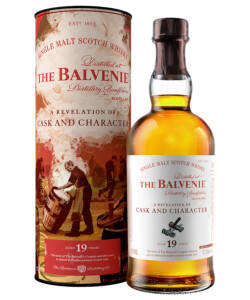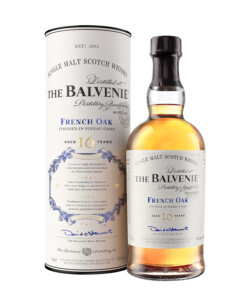Dufftown, Scotland, is considered the malt whisky capital of the world, with a whole host of Scotch whisky distilleries calling it their hometown. The Balvenie is one of them. The brand — founded by William Grant and owned today by William Grant & Sons — has been around since 1892, crafting a range of single malt whiskies.
While Balvenie makes news for its high-end, rare products, it is more than just a luxury brand. Bottles start at around $60 and are popular among value seekers who don’t want to compromise quality.
Now that you know the basics, here are 10 more things you should know about the Balvenie.
It’s got a lucky name.
Balvenie whisky shares a name with another Scotland tourist attraction, the Balvenie Castle. A historic piece of architecture built in the 1200s for Buchan earls, the Balvenie Castle got its name from the Scottish word for “village of luck.” While the castle fell into ruins as it aged, the Balvenie distillery has continued to assert its place in the Scotch whisky game in the 130 years since it was founded.
The Balvenie’s barley is made in house.
Few ingredients are as crucial to Scotch whisky as malted barley. In the olden days, whisky distillers often grew their own barley, then germinated it by spreading it across a large floor. The process was labor-intensive and involved employees regularly raking the grain to ensure it continued to grow properly.
At the turn of the 20th century, modern technology came to the rescue and most distilleries turned to other suppliers for their barley and malt. Not Balvenie. It’s one of only a few in Scotland that have on-staff farmers who grow and oversee the barley harvest, which is produced on a distillery-owned farm. It also continues to operate its own malting floor, malting a portion — but not all — of the barley used in its whiskies. These practices played a key role in the history of whisky making, and distilleries like Balvenie still swear by them today.
Malt master David C. Stewart makes Scotch fit for a queen.
The Balvenie’s malt master of 43 years, David C. Stewart, entered the Scotch whisky industry in 1962 and never looked back. He brings innovation to the field, trying out forward-thinking maturation techniques and producing beloved whiskies for the brand. He’s more than just a household name, though. In 2016, Stewart received the distinguished title of Member of the Most Excellent Order of the British Empire for his important work in the whisky industry. None other than the Queen herself presented him with his MBE.
Cask finishes all started in the Balvenie family.
Balvenie (and the rest of the world) has Stewart to thank for the creative idea of transferring mature whisky into other, previously used casks. The practice, referred to as wood or cask finishing, involves putting the whisky into casks that once held port, sherry, rum, or other liquids. It creates a more complex, flavor-rich finish on the final liquid. The Balvenie’s first cask-finished whisky, the Balvenie Classic, was released in 1983.
The brand loves a good story.
Most spirits brands love to tell tales of humble beginnings, important brand figures, and triumphant moments. Balvenie is no different, but it takes the spirit of storytelling a step further, with two whisky collections inspired by its history. The first is the Balvenie Stories line, which includes 12-, 14-, and 26-year aged whiskies. Each bottle comes with its own 30-minute audio clip featuring stories behind the whisky and interviews with Balvenie team members who helped create it. Additionally, a physical book that includes all three stories is available for purchase.
The second collection lets the whiskies themselves tell the story of Balvenie’s malt master. The DCS Compendium line features 25 rare whiskies divided into sets of five, meant to represent one of five distinct chapters of Stewart’s career. Each whisky is crafted by Stewart himself. The line is set to be released over a five-year period, and it will no doubt come with a price tag as high as the quality of liquid in the bottles.
It’s a bartender favorite.
Bartenders often reach for Balvenie when it’s time to pour a glass of Scotch for themselves. It’s been deemed a go-to for special occasions, an entry point into the category for new Scotch drinkers, and a brand that offers a bang for its buck.
Balvenie’s pairing recommendations might just be your cup of tea.
For those who start their mornings with tea and end their evenings with whisky, Balvenie proposes an important question: Why not put the two together? The brand pairs several of its whisky selections with tea varieties like oolong and jasmine, shares recommended preparation tips, and offers up tasting notes for drinkers to look out for. If cocktails are more your speed, Balvenie also offers recipes that combine tea and Scotch into refreshing, herbal drinks.
Keep an eye out for rare Balvenie whiskies at Costco.
If you’re shocked that the wholesale warehouse chain — best known for selling bulk items at low prices — also offers rare whisky for sale, you’re not alone. A 50-year single malt Scotch from Balvenie made its way onto a Washington, D.C., Costco’s shelf, nestled in a locked glass case, in 2021. The price tag? $29,999 at checkout.
Anthony Bourdain’s 2016 partnership with Balvenie made waves.
When the late world-renowned chef Anthony Bourdain partnered with Balvenie for a YouTube series featuring interviews with craftspeople across the U.S., it was a shock to his fans. Bourdain was notoriously anti-hipster and beefed with craft booze lovers — and, ironically, these were two central features of his Balvenie partnership. Yet partner he did, releasing 14 videos with the brand and sipping on its whisky throughout press tours across the country.
Now, Questlove’s a face of the brand.
In 2021, the Balvenie launched a new series, headed this time by musician-turned-Oscar-nominated-film-director Questlove. In the first season, Questlove chats with renowned creators across many disciplines — including Patti Smith, Malcolm Gladwell, and Michael Che — to discuss the art of craft. This impressive lineup may be the Scotland-based whisky brand’s way to catch the attention of American whisky drinkers.




